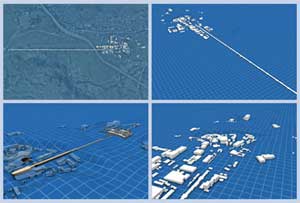

Tuesday - October 24, 2006
SLAC Today is available online at:
http://today.slac.stanford.edu
In this issue:
Symmetry: New Life for a Linac
Safety Today: Why Track Close Calls?
Reminder: Public Lecture Tonight
SLAC Walk & Run
Safety Second
 |
 |
|
Tuesday - October 24, 2006 |

Four views of a 3-D model of the linac and the Linac Coherent Light Source (LCLS). (Images courtesy of
Greg Stewart.) symmetry: New Life for a LinacForty-year-old scientific equipment tends to live in storage closets, recycling yards, or the occasional museum. However, the 3-kilometer-long Stanford Linear Accelerator, built in 1966, is merely reaching middle age. Still doing what it knows best—boosting bunches of electrons to near the speed of light—the linear accelerator, or "linac" to its friends, will soon start a new stage of life. As the source of electrons for a new type of laser, it will be able to see materials, atoms, and molecules, in a completely new way, illuminating new vistas on clean energy, medicine, nanotechnology, and planetary science. The linac already has an impressive résumé. At the top of the list, no doubt, are the three Nobel prizes it helped to win. It has contributed to a surprisingly wide range of experiments in particle physics, astrophysics, photon science, high-energy nuclear physics, and accelerator science. It also holds a number of titles, such as longest linac and first linear collider. Read more in symmetry... |
||
|
|
||

Why Track Close Calls?
Was previous reporting of the o-ring degradation a Close Call? A Close Call is defined as an unplanned sequence of events that could have caused harm if conditions were different or are allowed to progress, but did not in this instance. In hindsight, this disaster may have been prevented. Why track Close Calls? The behaviors and conditions that lead to actual accidents and injuries are the same as those involved in Close Calls. If we can get an idea of what almost happened, we can help prevent accidents and injuries that do happen. This is a much cheaper method of prophylaxis (both in terms of human and financial costs).
In 1931, H.W. Heinrich reported on a study of accidents that he classified according to severity. Heinrich's report showed that for each serious-injury incident, we could expect about 29 minor injuries and 300 Close Call or property-damage incidents, as represented in the above diagram. Read more... |
Reminder: Public
|
Events (see all | submit)
Access (see all)
Announcements
|
| | ||
|
|
||
 <%
Response.AddHeader "Last-modified", getArticleDate()
'Response.AddHeader "Last-modified","Mon, 01 Sep 1997 01:03:33 GMT"
'Monday, December 06, 2010
%>
<%
Response.AddHeader "Last-modified", getArticleDate()
'Response.AddHeader "Last-modified","Mon, 01 Sep 1997 01:03:33 GMT"
'Monday, December 06, 2010
%>View online at http://today.slac.stanford.edu/ |
||